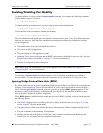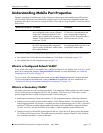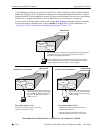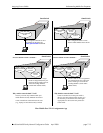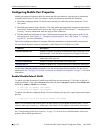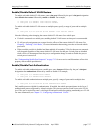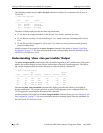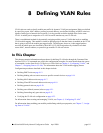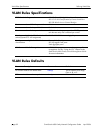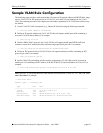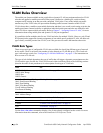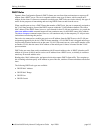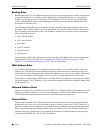
Assigning Ports to VLANs Verifying VLAN Port Associations and Mobile Port Properties
OmniSwitch 6600 Family Network Configuration Guide April 2006 page 7-19
Verifying VLAN Port Associations and Mobile
Port Properties
To display a list of VLAN port assignments or the status of mobile port properties, use the show
commands listed below:
Understanding ‘show vlan port’ Output
Each line of the show vlan port command display corresponds to a single VLAN port association (VPA).
In addition to showing the VLAN ID and slot/port number, the VPA type and current status of each asso-
ciation are also provided.
The VPA type indicates that one of the following methods was used to create the VPA:
The VPA status indicates one of the following:
show vlan port Displays a list of VLAN port assignments, including the type and status
for each assignment
show vlan port mobile Displays the mobile status and current mobile parameter values for each
port.
Type Description
default The port was statically assigned to the VLAN using the vlan port default
command. The VLAN is now the port’s configured default VLAN.
qtagged The port was statically assigned to the VLAN using the vlan 802.1q com-
mand. The VLAN is a static secondary VLAN for the 802.1Q tagged port.
mobile The port is mobile and was dynamically assigned when traffic received on
the port matched VLAN criteria (VLAN rules or tagged VLAN ID). The
VLAN is a dynamic secondary VLAN assignment for the mobile port.
mirror The port is assigned to the VLAN because it is configured to mirror another
port that is assigned to the same VLAN. For more information about the
Port Mirroring feature, see Chapter 27, “Diagnosing Switch Problems.”
Status Description
inactive Port is not active (administratively disabled, down, or nothing connected to
the port) for the VPA.
blocking Port is active, but not forwarding traffic for the VPA.
forwarding Port is forwarding all traffic for the VPA.
filtering Mobile port traffic is filtered for the VPA; only traffic received on the port
that matches VLAN rules is forwarded. Occurs when a mobile port’s VLAN
is administratively disabled or the port’s default VLAN status is disabled.
Does not apply to fixed ports.



